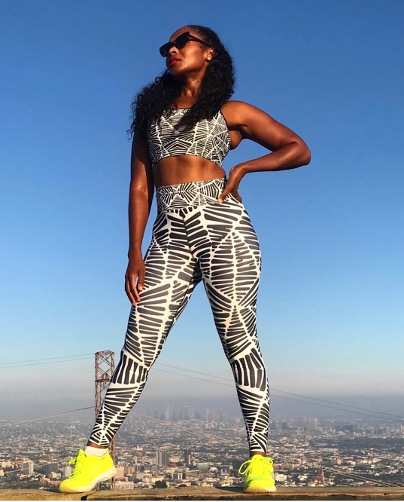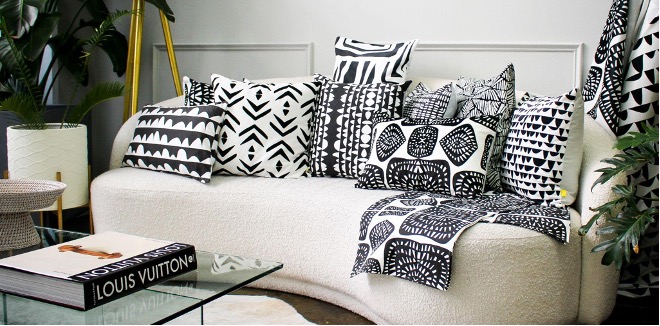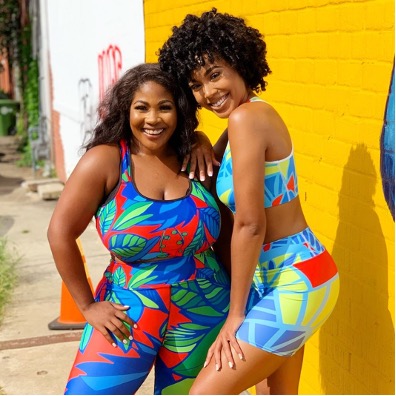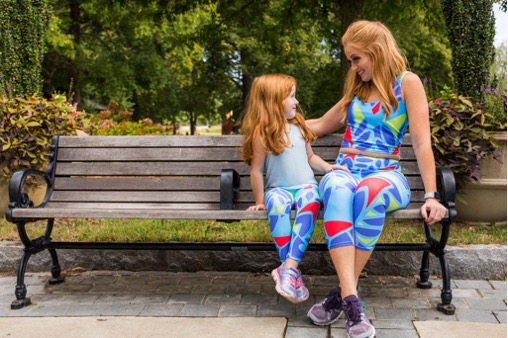Featured Conversation
True to its tagline, “Design for Abundant Living,” Rochelle Porter Design (RPD) believes everyone along the value chain should have the chance to live well. RPD prioritizes fair pay and the use of organic materials whenever possible. Their goal is to “Create the flyest possible products while doing the least possible harm.” GSIC spoke with Rochelle Porter to learn more about her company and commitment to ethics, sustainability, and creating beautiful products.
July 6, 2022
By: Kayla Jones, GSIC Social Impact Fellow
GSIC: Thanks so much for being here. We’d love to hear about your journey as a designer and what inspires you as you design.
Rochelle: Well actually, designing wasn’t always a dream that I had. I have no formal art background or ever thought about a design career growing up. I come from a very traditional immigrant, West Indian family. My family’s Guyanese and I was born there. And, with many immigrant families, you come to the U.S., you go to a good school, and you get a job as a doctor, lawyer, or engineer. So that was all I knew. I didn’t have any interest in any of those fields really, or any desire or any inclination toward them.
A career in design or art was not one of the job options. But I always doodled as a kid, and as an adult, I doodled on anything I could find. It wasn’t something I saw as a skill or a talent or anything particularly amazing. It was just what I did. It was more like a compulsion than anything. I mean, from you know, drawing on the corner of your books in school, to me being in corporate America and being in like, three-hour-long meetings. People thought I was taking notes voraciously, and it was a whole legal pad full of my doodles! That’s how I made it through those meetings. But I never really thought much of a career in design.
A few weird and pivotal things happened, though. So, I ended up majoring in English and History in college, much to my family’s chagrin. And my first job out of college was as a computer programmer. I hated the job and it was a horrible fit for me, but it was at a Fortune 100 company in Manhattan. I had “arrived.” I was wearing a suit every day, my family was proud, and everything seemed great. But really, I was dying inside. And I knew I was “creative,” but I would have never called myself an artist or anything. So just as an outlet, I took a class at FIT – Fashion Institute of Technology in New York. It was an Intro to Fashion Design class and I took it about 20 years ago at this point. It was only a three-day class and I went to the first two days. The instructor told us that if we wanted to get our products made, we’d have to go to China. I thought to myself doing production in China probably meant human rights violations, child labor, pollution, horrible worker conditions, and all these things that I had no interest in being involved in or perpetuating. So I didn’t bother going to third class and just moved on with my life.
Fast forward over a decade, and I started learning that sustainable fashion was a ‘thing.’ I didn’t initially have a great interest in it. I just knew what went into fast fashion, and I knew that it was bad; I didn’t want to be involved. So I felt encouraged when I learned about sustainable fashion. I took another class one day, but it wasn’t an art class in the traditional sense. It was a class about finding your heart as an artist and learning about how God created us to be creative. It was incredibly life-changing for me. I remember there was a woman in the class with me, and I didn’t know her at the time; but she looked at me and said, “I feel like there’s a dream that you had a long time ago that you put down. But I think God wants you to pick it back up now.” It was nice for her to say that, but not impressed (laughs). I was not impressed because I had picked up so many things from the time I took the FIT class until that moment. I filed the art dream in the back of my brain. And then another instance happened when, I was getting on a flight, and a Delta agent said my name sounded like a clothing line. Things like that kept happening for about a year and a half, and then I finally said to myself, “Okay, I’m listening, what’s going on? Clearly, there’s something here.”
The real turning point for me was going into some department store – it could have been Target or Nordstrom. I saw the stuff on the shelves – clothing, coffee mugs, greeting cards – and they all had these prints on them. The prints looked like things that I doodled. So I started asking myself, “How do people do that?” “How do people get artwork onto products?” I did my research, and found that it was an actual field called “Surface Pattern Design.” People did it for a living, and they had trade shows and conferences, too. I eventually went to the shows and conferences, and it kind of clicked from there. That’s the short version of how I got started!

GSIC: Thank you for sharing. Your designs are beautiful. Can you speak more about the surface pattern design style?
Rochelle: It’s called surface pattern design, so anything that has a surface. Textile design is probably what people are most familiar with. But surface pattern design isn’t just textiles. It could be a phone case, wallpaper, fabric – anything that can have a print on it, basically.
GSIC: Thanks for explaining that! Are there any unique challenges you’ve faced while navigating the industry?
Rochelle: Okay, sure. So while I do make apparel products, I actually kind of hate the fashion industry. I love style, I love clothing as a form of self-expression, and I love that you can tell who somebody is without them even saying a word sometimes. That’s amazing to me and it’s beautiful. The industry, of course, is racist, sexist, and not particularly size-inclusive, either. So with my activewear line, specifically, the sizes go from extra small to 6x. We really try to have something for every body type. There are a variety of prints for people who are really bold with color, or a little more conservative. It’s focused on making everything a lot more inclusive.
The sustainability aspect of that is a challenge. Because if you’re using stretchy material, there’s not a whole lot of 100% sustainable options. For example, you can’t make an organic cotton pair of leggings. So the materials are not the most eco-friendly, but our production method is. We use a ‘print on demand’ model, so the item doesn’t get made until the customer orders it. The item then gets printed, cut, sewn, and sent to them in about a week and a half. That way, it’s less likely to end up in a landfill somewhere or languishing on a shelf, or a warehouse. So we try to be mindful of that.
Right now, we source organic cotton and use eco-friendly dyes for printing. This production happens in North Carolina. We try to keep our carbon footprint really low by being as local as possible. We actually have some of our decor made by Amani Women’s Center, which is run by Doris Mukangu, who’s also a Start:ME alum. Her sewing academy is focused on the Clarkston immigrant community. They train them to get to a level where they’re really good and then they start doing production in manufacturing for brands. By using local workers, I know that people are being treated well and paid fairly. They also just do a great job of production.

GSIC: That’s great. You recently collaborated with West Elm, congrats on that accomplishment! How do you decide on who to partner with and where to sell your products?
Rochelle: Thank you. That’s an interesting story. With West Elm, the partnership came about in a sort of unconventional way. I had been doing pop-up shops at their stores for years. I heard that independent designers could do pop-up shops in their stores. So I went to one and was like, “Hey, I got these pillows.” (laughs) I had done that for about four or five years before anything was actually sold on westelm.com. But with everything that happened in 2020, with all the social unrest, brands started to make an effort to support Black businesses and Black designers.
Many brands took the 15% pledge after George Floyd’s death. The pledge was started by a designer named Aurora James who said to brands, “Here’s what you can do. Since Black people comprise roughly 15% of the population, we should be 15% of the products that are on your shelves.” West Elm was one of the first brands to take the pledge. I already had a relationship with them, so it was sort of a ‘no brainer,’ and the partnership happened seamlessly. They’re a company that values sustainability, individuality, and different kinds of expression. Their ethos aligned with what I was doing anyway, and it just made sense. They’ve been a great partner. As we grow and expand into other retailers, it’s important for me to vet them by asking, “Do they actually fit with my brand?”

GSIC: That sounds really hard to do.
Rochelle: It’s definitely a challenge. If I was making some mass-produced, fad product, it probably would be a lot easier and more lucrative on the front end. But I’m trying to build a brand with longevity, values, and hopefully some influence on the rest of the industry going forward.

GSIC: This has been wonderful. Thank you for your time! Where can we find out more about Rochelle Porter Design?
Rochelle: You’re welcome! Thanks for having me. You can find us in West Elm and Home Goods and online at RochellePorter.com.
###

